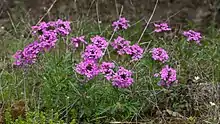Verbena canadensis
Verbena canadensis (syn. Glandularia canadensis), commonly known as rose mock vervain,[2] rose verbena,[3] clump verbena[4] or rose vervain[5] is a perennial herbaceous flowering plant in the verbena family (Verbenaceae) with showy pink to purple flowers.. It is native to the eastern and south-central areas of the United States.[1] This species is widely cultivated as an ornamental, and naturalized populations have been established outside its native range, such as in the northeastern U.S.[6][7]
| Verbena canadensis | |
|---|---|
 | |
| Scientific classification | |
| Kingdom: | Plantae |
| Clade: | Tracheophytes |
| Clade: | Angiosperms |
| Clade: | Eudicots |
| Clade: | Asterids |
| Order: | Lamiales |
| Family: | Verbenaceae |
| Genus: | Verbena |
| Species: | V. canadensis |
| Binomial name | |
| Verbena canadensis | |
| Synonyms[1] | |
|
List
| |
Description
V. canadensis is a perennial herb[8] that grows low to the ground, typically to about 1 foot (30 cm) high. Roots will form where stems touch the ground, and over time the plant will spread to form a low mound.[9] Leaves, up to 8 centimetres (3 in)long, are dark green on the upper surface and lighter green below. Leaves are semi-evergreen, opposite and pinnately-lobed.[4] Flowers are pink to purple, and consist of a tubular corolla that opens up into 4 or 5 spreading lobes. Flowers bloom in the spring and can persist until fall.[7] The plant attracts butterflies, rabbits, and deer.[8]
Distribution and habitat
Its natural habitat is in sunny areas such as glades, forest openings, and on bluffs.[7][10] It is tolerant of dry conditions.[11] In some areas, the presence of Verbena canadensis is indicative of high-quality natural communities.[10]
References
- "Verbena canadensis (L.) Britton". Plants of the World Online. Royal Botanic Gardens, Kew. Retrieved 4 December 2021.
- "USDA Plants Database". plants.usda.gov.
- Denison, Edgar (2017). Missouri Wildflowers (Sixth ed.). Conservation Commission of the State of Missouri. p. 55. ISBN 978-1-887247-59-7.
- "Verbena canadensis (Clump Verbena, Rosa Verbena, Rose Vervain) North Carolina Extension Gardener Plant Toolbox". plants.ces.ncsu.edu. Retrieved 2021-12-04.
- "Glandularia canadensis - Plant Finder". www.missouribotanicalgarden.org. Retrieved 2021-12-04.
- Glandularia canadensis New England Wildflower Society
- Yatskievych, George (2013). Flora of Missouri, Volume 3. Missouri Botanical Garden Press. p. 1208.
- "Lady Bird Johnson Wildflower Center - The University of Texas at Austin". www.wildflower.org. Retrieved 2021-12-04.
- "Know Your Natives – Rose Vervain". Arkansas Native Plant Society. 13 February 2018.
- Rose Vervain Glandularia canadensis Illinois Wildflowers
- Verbena canadensis MissouriPlants
